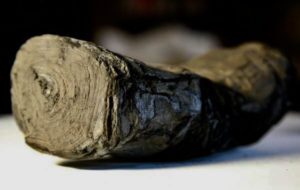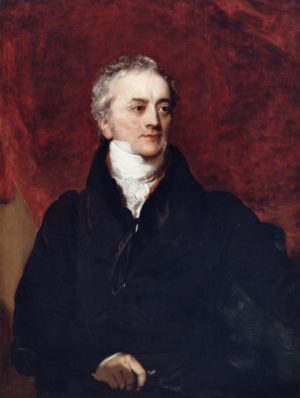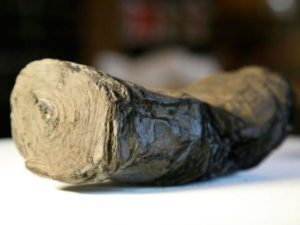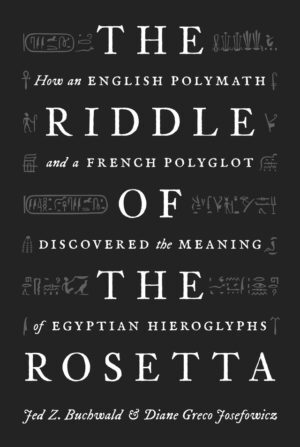
For years after England’s defeat of the French in Egypt, ancient Egyptian artifacts streamed into England. The most famous of these, the Rosetta Stone, was unveiled in 1802; in 1808, the architect Sir John Soane famously gutted his Holborn residence, creating a top-lit, three-story void, at the bottom of which reposed an Egyptian sarcophagus, glittering with traces of its original gilt. But not every dislocated artifact enjoyed such a celebratory reception. Smaller, less attention-grabbing items also circulated, mainly among specialists and antiquarians, providing less spectacular but arguably more meaningful opportunities for scholars to engage with the ancient past.
One of these modest artifacts was a cache of carbonized papyri scrolls discovered in the ruins of Herculaneum. Found in Naples when the city became an English protectorate, the rolls came to the attention of the Prince of Wales who, during the six years of English rule that followed, spearheaded an effort to unroll and transcribe them. He selected the Reverend John Hayter, future chaplain to George IV, to oversee the project. In 1800, Hayter claimed to have opened two hundred of the charred scrolls. Two assistants, Carlo Orazj and Giuseppe Casanova, produced apographs (scribal facsimiles) of some, if not all, of them.
When the French reconquered Naples in 1806, the court absconded to Palermo with the apographs. In August 1807, the newly appointed English plenipotentiary to the area, William Drummond, convinced the court at Palermo to hand them over. He passed them to Hayter, who managed to engrave only part of one. This disappointing performance may have reflected the encroachment of other interests, since a year later Drummond excoriated him for his involvement in a series of sexual scandals, including one involving a Neapolitan baron’s daughter. “I am sick of the stories of your battles in the brothels,” Drummond griped, not omitting to point out that even while at Naples, Hayter had opened only half as many scrolls as he had claimed. After dismissing Hayter, Drummond convinced the court to allow the apographs to be sent to England for publication under the auspices of their longtime royal champion the Prince of Wales, who transferred them to Oxford, where they remain.
 Meanwhile, a set of similar scrolls had come to the attention of one Thomas Young. Young [pictured right], who eventually made a serious bid to decipher the Egyptian hieroglyphs, was at this time merely an up-and-coming London physician and occasionally dabbler in ancient scripts. A handful of people, including officials from the Royal Society and the British Museum, were attempting to determine the best method of unrolling the papyri, and Young was selected to assist. His medical and scientific training were particular points of favor, for he was known “to have formerly employed himself in minute anatomy” and had considerable skill in experimental physics and chemistry.
Meanwhile, a set of similar scrolls had come to the attention of one Thomas Young. Young [pictured right], who eventually made a serious bid to decipher the Egyptian hieroglyphs, was at this time merely an up-and-coming London physician and occasionally dabbler in ancient scripts. A handful of people, including officials from the Royal Society and the British Museum, were attempting to determine the best method of unrolling the papyri, and Young was selected to assist. His medical and scientific training were particular points of favor, for he was known “to have formerly employed himself in minute anatomy” and had considerable skill in experimental physics and chemistry.
Working on the scrolls, Young experienced firsthand the physicality of an ancient object. The scrolls’ recalcitrant forms, their materiality, demanded his dexterity, honed from years of painstaking anatomical dissection and experimental work. He was no less dexterous in making sense of these ancient linguistic remains by linking their spatial dispositions to meaning. These methods carried forward into his engagement with Egyptian hieroglyphs.
To unroll the papyri, Young devised a method that drew on his anatomical expertise. Breathing humid air through a tube onto the charred scroll, Young attempted to use an “anatomical blowpipe” instead of “a dissecting knife.” The method was reminiscent of one recalled, years later, by an unnamed fellow at Cambridge who had “once found [Young] blowing smoke through long tubes, and I afterwards saw a representation of the effect in the Transactions of the Royal Society to illustrate one of his papers upon sound.” To keep unfurled leaves apart, Young proposed the use of goldbeater’s skin, the fine coating of a lamb’s intestine used to make gold leaf, following the practice of Antonio Piaggi, a monk, who was the first and most successful unroller of papyri scrolls. When this expedient failed, Young tried “chemical agents of all kinds,” even “maceration for six months in water,” to little avail. He proposed, presciently enough, leaving to the future further work with these fragile relics.
In 1810, two classical scholars, William Drummond and Robert Walpole, published a volume, the Herculanensia, containing “archaeological and philological dissertations” on the papyri and transcriptions of “a manuscript found among the ruins of Herculaneum.” Walpole, a rector in Norfolk, had graduated Cambridge with a prize for a Greek ode; his translation of Greek comic fragments into Latin and English verse appeared in 1805. Drummond, of course, was the appalled administrator who had berated Hayter years before.
Drummond had by this time established himself as a classical scholar. In 1805, he published Academical Questions, a controversial plea for ancient philosophy as a prophylactic against dangers presented by modern thought. “Let not those, who would be steady in their opposition to all speculative reasoning, and who would still persevere in imposing new fetters on philosophy, ever tread the soil where the sages of Greece conversed with their disciples,” he opined. Translating the Herculaneum papyri, Drummond hoped to find support for his positions.
Dedicated to the Prince of Wales, the Herculanensia consisted of ten essays or “dissertations” ranging from the population and topography of Herculaneum through discussions of the Greek language, Roman painting, and materials used in writing. Some were written by Drummond, others by Walpole. The eighth, by Drummond, engaged the paleography of the scrolls. The ninth, also by Drummond, provided a discussion, transcription, and emended text of a “manuscript of Herculaneum” that, he claimed, bore the title περι των θεων (On the Gods)—and this was where he hoped to find the evidence he so badly needed.
Drummond maintained that the manuscript represented “the sentiments of an Epicurean, concerning the system of theism professed by the Stoics,” and that it had roused Cicero to write De Natura Deorum (On the Nature of the Gods). Drummond was not concerned with the transcription and emendation per se, for which he declared to have relied on the “Academicians of Portici,” a group that had been working with the papyri in Naples since the 1750s. These, he assumed, were the fragmented manuscript’s emending editors—a curious position since, having employed Hayter and his crew, he had good reason to think otherwise, for Hayter had authored both transcription and emendation. Rather, Drummond was principally interested in finding Epicurean accusations against the Stoics.
To Drummond, then, the scrolls represented an opportunity to pursue his philosophical axe-grinding. To others, the scrolls represented an opportunity to pursue the more modest work of correction and emendation. Charles James Blomfield, a fellow of Trinity College who reviewed the Herculanensia for the Edinburgh Review, was unenthused by the papyri, observing that at least one of the manuscripts “is in a very mutilated state; and, from the mode in which it is printed, any attempt to fill it up from conjecture is almost a hopeless task; but, in fact, it does not seem to be worth much trouble; and if all the unedited Papyri contain matter as little interesting as those already published, no good is likely to result from their being given to the world, but an accession to our stock of paleographical knowledge”—and not even that, he continued, “unless future editors will give accurate copies.” Following Drummond, Blomfield attributed the effort to correct parts that could not clearly be read to “the Academicians of Portici” whose labors were “often singularly unhappy, but sometimes successful.” Drummond had only offered “one or two conjectures” of his own, though nothing extensive; neither did he essay a translation.
As Blomfield’s review of the Herculanensia wended into print, Young was writing his own response, a substantial essay of twenty pages, for the Quarterly Review. Buoyed by his firsthand experiences with unrolling papyri scrolls, Young hailed the appearance of the Herculanensia, a “highly interesting volume,” as “a memorable event in the history of classical literature.” He commended the “profound erudition and extensive knowledge” of Drummond and Walpole, and even quoted at some length Drummond’s account of the scrolls’ history. Brief remarks, also positive, followed concerning the first four dissertations. But the fifth, by Drummond, attracted Young’s criticism. Drummond, he wrote, had been “somewhat precipitate in his conjecture respecting the sense of a passage in the Bacchae of Euripides,” which Young proceeded extensively to correct. He made other “observations” of this sort, his critique escalating until he reached the eighth dissertation, by Walpole, on paleography.
In 1807, Walpole had observed that all but one of the opened scrolls were written in Greek, in capital letters with neither spaces nor accents. Yet Walpole insisted that accents had existed as early as 248 BCE, citing for evidence the orthographic features of a Herculaneum wall inscription and passages from several authors. Young, in contrast, merely recurred to a “usual belief” that accents had been invented a half century later by Aristophanes of Byzantium. This apparently minor orthographic question was of surprisingly profound significance. Its resolution would shape any attempt to restore the text of the fragment, as specialists in paleography knew from long and hard experience.
Debates concerning Greek accents, particularly in ancient poetry, had been ongoing for at least a century and a half. In De poematum cantu et viribus rythmi (1673), the Dutch scholar Isaac Vossius had averred that accents were ignorable late inventions. A half-century later, John Foster, a master at Eton, where the use of accents in teaching Greek was a sine qua non, revived the matter. In a diatribe against Vossius, Foster claimed that orthographic elements such as accents were closely tied to pronunciation and to the anatomical organs of speech. According to Foster, Vossius had failed to consider that “as vocal sounds are formed by organs of speech which are essential and immutable parts of our nature, they must have been in all ages substantially and formally the same, tho’ variously modified in their application.” From this foundation, Foster constructed an argument “drawn from the nature of speech itself” as proof of the early existence of accents.
Young may not have read Foster—there is no evidence that he did—but he would certainly have agreed that inscription necessarily connected to speech. As a student, Young had been interested in phonemes in relation to writing, and he had absorbed the argument, made by the eighteenth-century grammarian Gregory Sharpe, that the earliest writing to capture speech—Hebrew, Sharpe believed—necessarily omitted accents. Although Young might have agreed with Sharpe about that, he had no doubts about the appropriateness of supplying accents to capture the sonic expressiveness of discourse. He even criticized Drummond for “disfiguring” his Greek by omitting them.
Just as Young took exception to Walpole and Drummond’s representation of pronunciation, he also objected to the transcription and translation of the manuscript fragment that appeared in Herculanensia. Because Young held that inscribed meaning depended upon the spatial imprinting of sound in specific ways, it was essential to consider the physical placement of words in the Herculaneum papyri. Young faulted Drummond’s transcriptions for being insufficiently attentive to location, in particular to the blank places where words might once have been. Attending to the spatial character of the scroll, Young proposed a different restitution of the passage. This effort elevated Young’s status as a classical scholar; no longer could he be considered a dilettante. According to his first biographer, Young’s review “at once placed its author, in the estimation of the public, in the first class of the scholars of the age.”
It is not hard to understand why. The differences between the Herculanensia’s fragment and Young’s reconstruction reflect his conviction that, when attempting to determine the meaning of inscriptions of a phonographic language, one must take into account the spatial arrangement of the inscription—and his results were surprisingly accurate.
Though he had not seen Casanova’s original, Young was skeptical of Hayter’s version, which departed from Casanova’s in several respects. Although the original was entirely uppercase and lacked spaces, Hayter had rendered it in lowercase with lacunae. He appended a reconstruction of the text that filled in these empty spaces, substituting words and phrases where Casanova struggled to read the text.
Certain that the sense of the document could only be divined from a reproduction that did not introduce such elements, Young produced “a specimen of the state of the manuscript,” giving “its first page, which is the most defective, as nearly as possible in the form in which we suppose it to stand.” To restore the physical form of the fragment, Young carefully reworked the Herculanensia text, eliminating spaces and using only uppercase letters. Young’s restoration matches up well with the original apograph—which, again, he had not seen. In line 17, for example, Young eliminated spaces and moved the letters, now uppercase, to the right, precisely as in the (unseen) apograph. To six lines of the Herculanensia version, Young added a letter to make sense of a word. In one amended line (no. 26) Young omitted six letters—των ανο—from the Herculanensia’s transcription. “This line,” Young wrote, “as printed, contains twenty-five letters, and is totally unintelligible.” But, Young continued, by omitting the offending phrase, the sense “may be made to accord perfectly with the context.” Comparing his version to the apograph by Casanova, we find that he has matched the spacing of the apograph correctly.
Not content merely to regenerate the original on which the apograph was based, Young next recreated the entire passage. His notes no longer survive, but they were available to Peacock as he wrote Young’s biography. According to Peacock, Young had worked “an exquisite copy of the entire manuscript— which is now before me—with the lacunae filled up in a differently coloured ink.” This expedient had eventuated in an “intelligible text, which is good Greek,” while allowing “the reader to judge of the propriety and probability of the restorations which are proposed, not only with reference to the space which they occupy, but likewise to the words or portions of words which precede and follow them.”
Young also found grounds for changing the fragment’s title. Instead of the Herculanensia’s περι των θεων (which appeared nowhere in the transcription), Young extracted ΠΕΡΙ ΕΥΣΕΒΕΙΑΣ ΚΑΤ ΕΠΙΚΟΥΡΟΝ from the final four lines, leading him to retitle the passage as “A Treatise on Piety, according to Epicurus.” This result differed completely from Drummond’s, with devastating effects on the latter’s argument concerning Cicero. Having translated the title as “On the Gods,” Drummond was convinced that the fragment had provided Cicero with the fourteenth, fifteenth, and sixteenth chapters of his De Natura Deorum, in which Cicero has Gaius Velleius represent Epicureans. Young demurred, and to prove the point he translated the passage of Cicero to which Drummond referred and listed the supposedly comparable lines. “The reports are not by any means so precisely similar,” he wrote, “as to induce us to suppose, that Cicero had ever undertaken the justifiable liberty of saving himself some little trouble by making use” of another author’s work. This coup de grâce was preceded by a complete translation into English of the re-created passage.
Triumphantly Young concluded: “We are very sorry to observe how lamentably the modern Academicians of Portici,” that is, Hayter, “have fallen short of their predecessors.” In response Hayter sought Drummond’s support. Young’s emendations to the apograph particularly irritated Hayter who, finding them entirely faulty, told Drummond that “the supposed facsimile of the Reviewer is not a facsimile of the original, neither in the distances, nor in the form of the characters.” Hayter may have claimed as much, but we have already seen that, “facsimile” or not, Young’s proposed revision of the transcription does fairly well match the original.
Because Young’s critique implicitly tarnished the diligence and competence of the apograph’s transcriber, Hayter devoted much of his reply to insisting that his dimensions for the lacunae were accurate. Not only had they been “taken with much care by the copyist,” but Hayter had also personally checked them against the original. He insisted that his own “conjectural letters” took account of potential sources of copying errors, and perhaps he had—though Young’s point was not that the Herculanensia’s transcription added too many letters for the extant spacing, but that it made little sense. Finally, Hayter claimed that, unlike his own reconstitution, Young’s emendations did not fit the apograph. In Young’s original “facsimile”—or a copy of it, obtained perhaps from Young himself—Hayter spied an apparent inconsistency with Young’s printed revision. In the ninth line of his reconstruction of the apograph, Young gave ΔωΡΕΑΝ, “free,” for Hayter’s lowercase δορεαν, whereas in Young’s proposed reconstitution, the word ΜωρΙαν, “folly,” appears instead. The apograph’s ninth line does seem to contain a Δ, but the letter, being broken, was hard to read. Young had substituted “folly” because the latter, which made sense in context, justified his emendation of a character that Casanova may well have mistaken. Hayter nevertheless fastened on this anomaly as evidence of Young’s incompetence.
_________________________________

A papyrus scroll, carbonized from the volcanic destruction of Herculaneum during the eruption of Mount Vesuvius in 79 AD. Paz estrada, Creative Commons Attribution-Share Alike 4.0 International license, Wikimedia Commons
_________________________________
With this foray into the words and inscriptions of antiquity, Young revived his longstanding interest in languages, their origins, and the ways in which their sounds could be visually represented; in this way, his immersion in the Herculaneum papyri prepared him for his confrontation with the scripts of ancient Egypt. His adversary, Hayter, did not benefit nearly as much. Printed privately, Hayter’s response seems to have had little effect, perhaps because he had unwisely included Drummond’s letter of rather lukewarm support with the publication. That Young’s review was published anonymously may have reduced any pressure he felt to reply, which he did not. The damage, at any rate, had been done. Four decades later, Peacock noted that “no subsequent attempt was made to re-establish the character of Mr. Hayter as a scholar, or to vindicate his conduct with respect to the abandonment of the papyri and of the copies made of them.”
_________________________________
Editor’s Note: Thomas Young later went on to make important contributions to the decipherment of Egyptian hieroglyphs, particularly the Rosetta Stone, before Jean-François Champollion expanded on his work and achieved the task.
This article is excerpted from THE RIDDLE OF THE ROSETTA: How an English Polymath and a French Polyglot Discovered the Meaning of Egyptian Hieroglyphs, by Jed Z. Buchwald and Diane Greco Josefowicz. Copyright © 2020 by Princeton University Press. Reprinted by permission.
 Readers who want to read more can purchase the book, The Riddle of the Rosetta, which will publish this fall (Sept. 15th, 2020). In this book, authors Jed Buchwald and Diane Josefowicz relate the story of the race between philologists Thomas Young and Francois Champollion to decipher the Rosetta Stone, including their different approaches to ancient Egyptian material culture. The book can be purchased at Princeton University Press.
Readers who want to read more can purchase the book, The Riddle of the Rosetta, which will publish this fall (Sept. 15th, 2020). In this book, authors Jed Buchwald and Diane Josefowicz relate the story of the race between philologists Thomas Young and Francois Champollion to decipher the Rosetta Stone, including their different approaches to ancient Egyptian material culture. The book can be purchased at Princeton University Press.
__________________________
Advertisement




